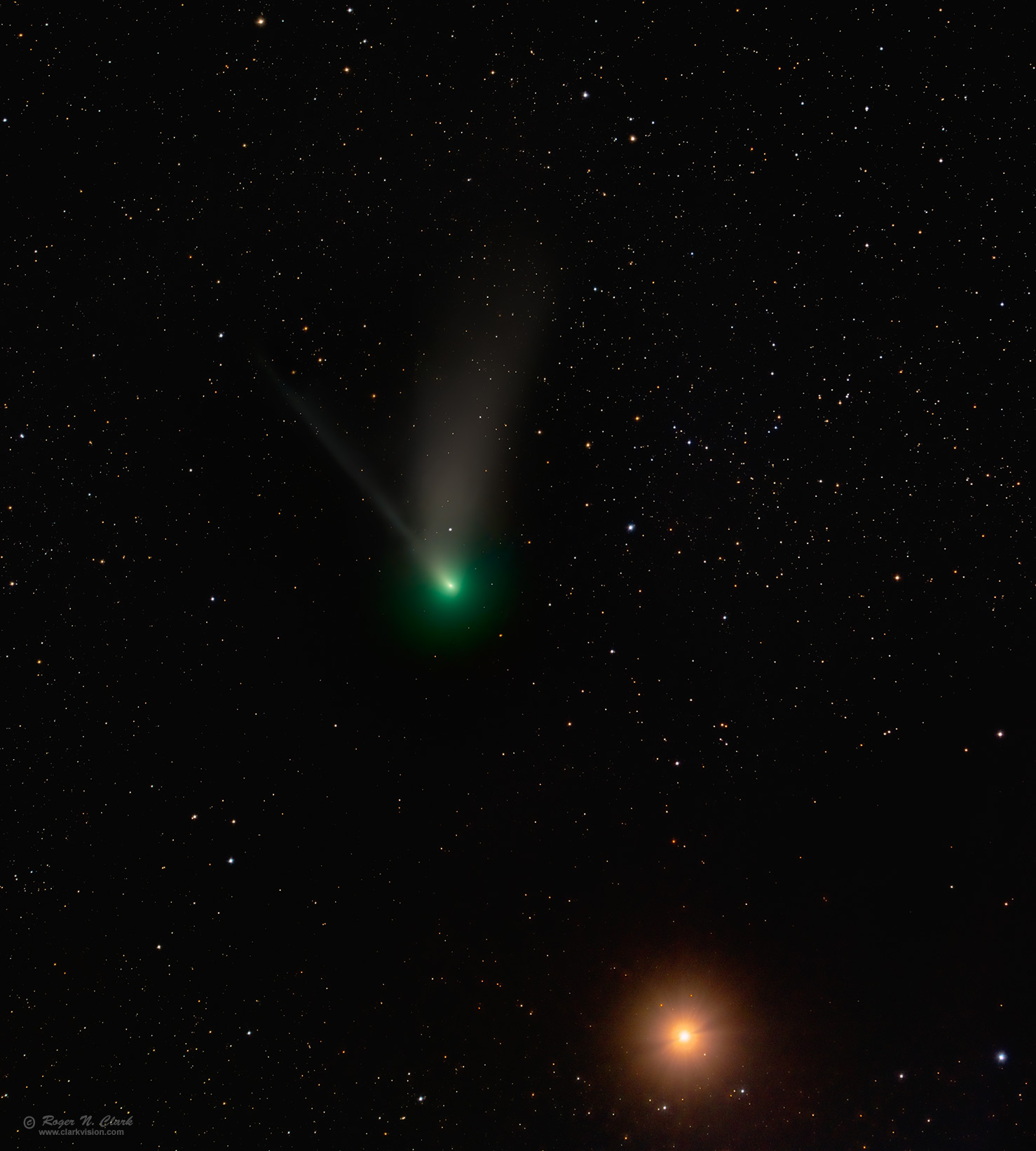| Home | Galleries | Articles | Reviews | Best Gear | New | About | Contact | Gallery Index | Previous |
Next |

| Home | Galleries | Articles | Reviews | Best Gear | New | About | Contact | Gallery Index | Previous |
Next |

Comet C/2022 E3 ZTF made a close pass of Earth a few days before this image was obtained on February 10. Due to perspective, the comet appeared near Mars (the bright red-orange object near the bottom of the frame). The green color is from emission by diatomic carbon (C2) with possible contribution from cyanogen (CN). The straight (type 1 ) tail is bluish molecules ionized by solar ultraviolet light. The yellow-ish dust tail (Type 2) is dragged into a fan shape by the solar radiation pressure on tiny dust grains, along with the orbital motion of the comet. The yellow is reflected sunlight off of small dust particles.
Technical. This image was obtained with a stock Canon EOS 90D DSLR Camera and a Canon 300 mm f/2.8 L IS II lens plus a 2x teleconverter (TC). The image was obtained in a heavy light polluted city (Bortle class 8), so exposure times had to be very short. The star background was made by averaging 143 8-second exposures with the 300 mm lens and no TC (ISO 1600 f/2.8). The comet was imaged with the TC, 393 images at 8-seconds each, ISO 3200, 600 mm f/5.6. Total exposure time was 19.07 minutes on the stars, 52.4 minutes on the comet. Raw conversion in rawtherapee to Rec2020 color space. Rawtherapee included lens profiles so the raw converted images are highly calibrated with a flat field (in the lens profile), bias corrected, and the sensor blocked dark current. The comet set was stacked by aligning on the comet, then Stretched with rnc-color-stretch, and downsized 2x to match the stars. The 300 mm 143 images were stacked aligning on the stars, stretched with rnc-color-stretch and the two images combined. The exposures were tracked on an iOptron HAE29EC strain-wave mount with high resolution encoders and no guiding. Original plate scale on the comet = 1.1 arc-seconds per pixel, and presented here at 6.6 arc-seoncds/pixel.
This is a natural color image.
The Exposure Factors, CEF, CEFA are measures of the relative amounts of light received from a subject. It can be used to fairly compare wildly different lens/telescope apertures and exposure times. For this image the, 52.4 minutes exposure on there comet yielded:
Modern digital cameras like the Canon 90D include on sensor dark current suppression technology and low fixed pattern noise at ISOs around 800 and higher, making no need for dark frame subtraction. Modern raw converters correct for light fall-off and also correct for hot/dead/stuck pixels. This makes processing low light images easy: simply align and average.
Also see Astrophotography Image Processing Basic Work Flow.
To learn how to obtain stunning images like this, please visit my Extensive Articles on Photography .
Keywords to this image = astrophoto-1 night low-light digital_astro comet canon_90d rnc-color-stretch
Image ID: comet-c2022ztf+mars-2023-02-10-btl8-rnclark-strs19m+comet53m.d-c1.33xs.jpg
| Home | Galleries | Articles | Reviews | Best Gear | Science | New | About | Contact |
Last updated November 08, 2025